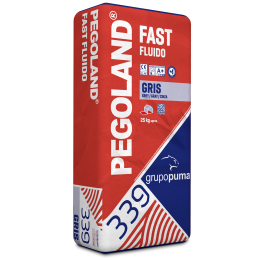 Pegoland® Fast Fluido C2 FE
Pegoland® Fast Fluido C2 FE

Flowable, fast-setting cementitious adhesive for installing indoor and outdoor floor coverings. Especially recommended for large-surface floors and radiant-heating screeds. Suitable for bonding all kinds of ceramic tiles.
Additional information
Technical Caracteristics
Formulated with high-strength cements, selected aggregates, additives and synthetic resins that provide a rapid return to service and very high bond strength.
Advantages and Uses
- Indoor and outdoor flooring installations
- Bonds every type of ceramic tile Ideal for large-format pieces High water-retention, so neither tiles nor substrates need pre-wetting Excellent initial grab
- Bonds every type of ceramic tile Compatible with porcelain stoneware Tailored for outdoor installation of marble, granite and natural stone (salt-free, fast-drying)
- Suitable for large, high-traffic areas Can be used in cold-storage rooms—rapid hardening
- Flowable product with strong wetting capacity
Suitable Substrates
- Conventional cement-based screeds.
- Overlays on marble, granite, terrazzo, natural stone or any ceramic surface, indoors and outdoors.
- Ceramic installation over radiant-heating floors.
- Substrates must be strong, stable, sound and clean—free from dust, release agents, organic matter, etc. and must have adequate flatness. If necessary, level up to 5 mm with the same product 48 h before tiling.
- For thicker levelling:
- On screeds, use NIVELAND 10R or PAVILAND SELF-LEVELLING SCREED as required.
- In heat, wind or on very absorbent substrates: dampen the substrate and allow the film of water to disappear before applying.
- Do not apply over paints.
- Outdoor floors must have ≥ 1 % fall.
- Do not apply on gypsum, anhydrite or other sulphate-rich substrates, nor where they may be exposed to water or moisture rich in sulphates.
- All substrates must comply with § 6.4 of UNE 138002.
Application Procedure
- Add water and mix by hand or mechanically until it takes on an even and workable consistency (6.5 to 7 litres per bag).
- Let the mixture stand for 2 minutes and remix.
- Spread the mixed product on the substrate with a trowel to a maximum surface area of 2m2.
- Spread with a notched trowel to adjust thickness (see chart).
- Place the pieces on the fresh adhesive, pressing and moving until the grooves are completely crushed and the entire surface of the ceramic is properly adhered, periodically check the stickiness of the adhesive by lifting a previously laid tile, if a non-transfer film appears on the surface of the adhesive, or dehydration of the adhesive, proceed to remove the material and apply a new product.
- Observe construction joints (expansion, contraction, fraction, perimeter corner joints) and the joints between the cement slabs (minimum of 2 mm inside and 5 mm outside).
- After 8 hours, use the appropriate mortar from the MORCEMCOLOR range depending on the type of joint.
NOTE: For better results lay tiles as soon as possible after spreading.
Notched-trowel panel
| TILE FORMAT | NOTCHED TROWEL | BONDING |
| < 1.600 cm2 | U9 (9 x 9 x 9) | Simple |
| > 1.600 cm2 | n10 | Simple |
Recommendations
- The service life of a tiled installation can only be ensured through proper planning. Therefore, always consult the current national standards in each country—e.g., the UNE 138002 standard in Spain, which gives specifications on material selection, correct planning, use and installation in order to achieve the required levels of quality, performance and durability.
- Do not apply below 5 °C or above 35 °C, or when there is risk of frost, rain, strong winds or direct sunlight. Extreme weather (high wind or very high temperature) accelerates drying.
- Ambient temperature, ventilation, substrate absorption and covering materials can alter the working and setting times of the adhesive.
- Never use the “dot-and-dab” method.
- Do not install in areas where standing water may occur.
- Respect all movement joints (structural, contraction, expansion and perimeter) as specified in § 7.8 of UNE 138002. These joints may be handled with prefabricated profiles or filled with a PUMALASTIC-series elastic sealant.
Sizing of Expansion Joints
| Application scope | Location and dimensions | Width of the joint mm |
| Exterior walls | - Under each slab - Separation length 3 m - 4 m linear - Maximum regular area. 16 m2 |
≥ 8 mm |
| Interior floors | - Respect open contraction joints - Otherwise: separation length ≤ 8 m linear - Maximum regular area 40 m2 |
≥ 5 mm |
| Exterior floors | - Separation length 2.5 m - 5 m linear - Maximum regular area 16 m2 |
≥ 8 mm |
| Singular points | - Door steps - Changes of floors |
|
| NOTE When these joints affect every coat in the ceramic system, they must meet the conditions of shrinkage joints. | ||
Dimensioning of perimeter joints
| Application scope | Location and dimensions | Width of the joint mm |
| Interior walls | - Perimeter joints - Wall / ceiling intersection |
≥ 8 mm |
| - Wall / wall intersection | ≥ 5 mm | |
| Exterior walls | - Interior corners of the building - Exterior corners of the building |
≥ 8 mm |
| Interior floors - Monolithic - Parquet |
- Perimeter joints and intersections with other elements or devices | |
| Exterior floors | - Perimeter joints and intersections with other elements or devices. | |
| Singular points | - Joints intersections in carpentry meetings | ≥ 5 mm |
- On radiant-heating floors, apply only when the substrate is at room temperature (between 5 °C and 30 °C). For radiant-heating floors, the heating must be switched off for at least 48 hours beforehand, and it must be restarted gradually no sooner than 7 days after the flooring has been laid and grouted.
- For overlaying on existing ceramic surfaces, remove poorly bonded tiles and fill any voids with mortar the day before the product is applied. Make sure the old ceramic is free from grease or wax; if necessary, grind the glazed surface until the original shine is lost. If in doubt, carry out a preliminary test to confirm the suitability of the proposed solution.
- For tiles reinforced with a fiberglass mesh on the back, consult the technical department.
Packaging and Storage
25 kg plastic-lined paper bags
Shelf life: 6 months in sealed original packaging, sheltered from weather conditions and humidity.
Technical data
(Statistical data obtained under standard conditions)
| Aspect | GREY powder |
| Apparent density (powder) | 1,3 ± 0,2 g/cm3 |
| Density (mixed product) | 1,5 ± 0,2 g/cm3 |
| Adjustment time Approx. | Approx. 30 min. (depending on weather conditions) |
| Paste shelf life Approx. | Approx. 1 hour (depending on weather conditions) |
| Waiting time before usage | 8 hours after the start of setting |
| Setting time at 23ºC±2ºC Approx. | 2 hours 30 minutes (depending on weather conditions) |
| Adherence after 6 hours | ≥ 0,5 N/mm2 |
| Initial tensile adhesion strenght | ≥ 1 N/mm2 |
| Tensile adhesion strenght after water inmersion | ≥ 1 N/mm2 |
| Tensile adhesion strenght after heat ageing | ≥ 1 N/mm2 |
| Tensile adhesion strenght after freeze-thaw cycles | ≥ 1 N/mm2 |
| Service temperature | -30ºC a 90ºC |
| UNE-EN 12004 Classification | C2 FE |
| Approximate yield | 4 Kg/m2 |
Environmental Product Declaration (EPD)
Cement based mortar prepared with aggregates that are supplied close to the production center, which reduces the greenhouse gas emissions that would otherwise arise from their transport. Manufactured in production centers with an Environmental management certified system following ISO 14001 regulation, offering a firm promise of sustainability and respect for the environment.
Cement based mortar with type III ecological label (the most strict) Environmental Product Declaration verified externally by AENOR.
Legal Disclaimer
GRUPO PUMA is not responsible, in any case, for the application of its products or constructive solutions carried out by the application company or other parties involved in the process and / or execution of the work, limiting the responsibility of GRUPO PUMA exclusively to the damages directly attributable to the supplied products, individually or integrated in systems, due to failures in their manufacturing process.
In any case, the drafter of the work project, the technical management or the person responsible for the work, or collaterally the application company or other parties involved in the process and / or execution of the work, must ensure the suitability of the products addressing the characteristics of them, as well as the conditions, support and possible pathologies of the work in question.
The values obtained by GRUPO PUMAS's products or its constructive solutions that, as the case may be, are determined by the EN standards or any other regulation that applies to it in each case refers exclusively to the conditions specifically stipulated in said regulation and that are referred to, among others, to certain characteristics of the support, humidity and temperature conditions, etc. without being them required in the tests obtained under different conditions, all in accordance with the relevant regulation.